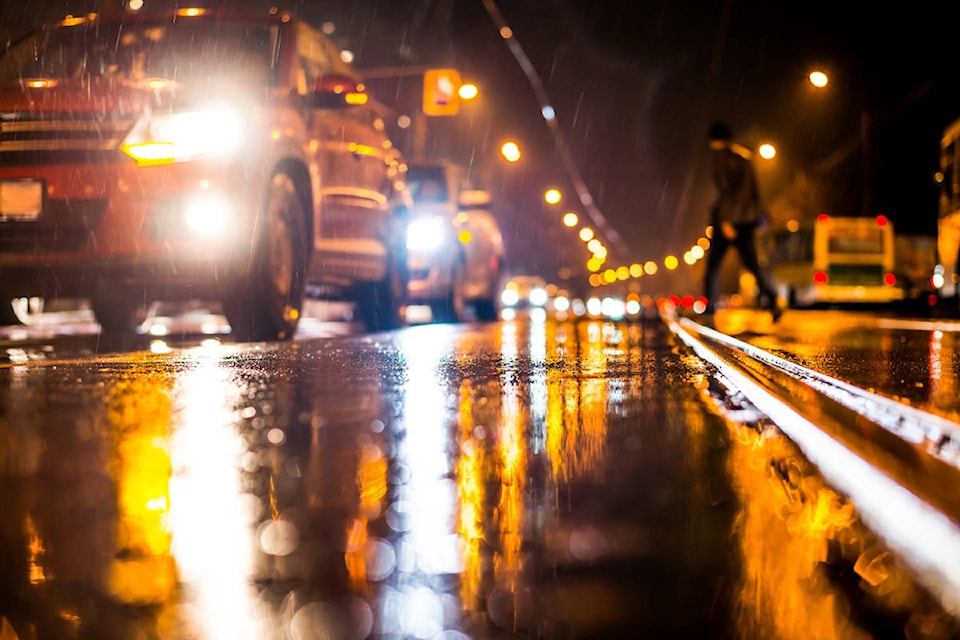A pedestrian is wandering, perhaps stumbling, within the vehicle lanes of the highway going through West Kelowna. There is no natural light at 4:30 a.m. on that October 21, 2017, morning.
He is struck and killed.
A news report commends the quick actions of the driver and passenger of the striking vehicle, leaping into action to perform CPR.
How horrific.
I spoke to a motorist who had come down that same stretch of highway just minutes before. He was driving in the left of the two northbound lanes. The pedestrian’s existence in the middle of the road came as a shock to him when the pedestrian’s arm struck the car.
Our hearts immediately feel for the motorists who became victims of that drug and/or alcohol impaired pedestrian. Not only were they physically injured in the crash, the traumatic experience will stay with them forever.
It could just as easily have been any one of us.
Yes, it could. But what does that say about our driving attitudes?
I conducted a disturbing examination for discovery recently. The defendant I examined was clearly of the view that if he was “in the right,” he had no obligation to adjust his driving if another motorist is “in the wrong.”
You’re driving down a highway at 4:30 a.m. You have right of way.
But we have decided, as a society, that motorists should take care not to run over jaywalkers. Check out this specific legal duty contained within the Motor Vehicle Act to “…exercise due care to avoid colliding with a pedestrian who is on the highway.” (See section 181).
And the law has long established that regardless of who has the right of way, both parties have a duty to exercise due care (see Wong-Lai v. Ong, 2011 BCSC 1260, paragraph 55).
We have a much higher legal duty, as drivers, than keeping our vehicles “between the lines,” stopping for stop signs and red lights, and keeping within the speed limit.
Might that also be a moral duty? Laws be damned, might it be reasonable that we keep a look out to prevent running over pedestrians? Even those wandering around drunk and/or stoned at 4:30 a.m.?
But it was dark.
Without a reflector vest or otherwise highly reflective clothing, a pedestrian will blend into the darkness just like a deer or a moose.
But unlike a deer or moose, pedestrians don’t typically leap out from behind bushes or out of ditches.
If you are keeping a careful look-out to see what’s going on ahead of you, would you notice a pedestrian before the moment that you strike them?
If not, are you over-driving your headlights?
Let’s say you did happen to notice a pedestrian walking along a highway at 4:30 a.m. Would you automatically slow down and move into the left lane as a precaution?
It’s a legal requirement if there is an emergency vehicle, tow truck, etc., with flashing lights sitting on the shoulder (see section 47.02 of the Motor Vehicle Act Regulations).
Might a pedestrian at that hour command a similar, cautious response? That way, if the pedestrian is drunk and/or stoned (perhaps a likelihood at 4:30 a.m.), stepping into your lane will not kill them.
Of course, if you noticed the pedestrian in your lane, you would slam on the brakes and swerve to miss them.
Step one noticing. Noticing requires keeping a careful look-out and not over-driving your headlights.
Is that too much to ask of each and every one of us? At all times?
PLEASE NOTE: I was not there. I did not investigate the incident. I have not spoken to anyone other than the witness I referred to. I don’t know if the pedestrian was drunk/stoned or sober. My heart goes to all involved. I am hopeful that this tragedy might help us adjust our driving attitudes and behaviours to help prevent road traffic tragedies.
